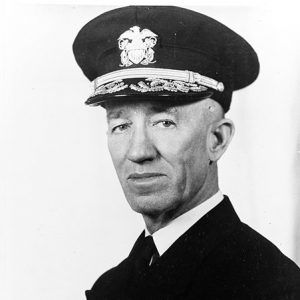calsfoundation@cals.org
Charles Maynard "Savvy" Cooke Jr. (1886–1970)
Fort Smith (Sebastian County) native Charles Maynard “Savvy” Cooke Jr. rose through the ranks of the U.S. Navy from academy cadet to four-star admiral during an extraordinary career spanning more than two decades and two world wars. He survived a sinking submarine; came under attack at Pearl Harbor; had shrapnel strike his helmet on Omaha Beach during the D-Day invasion; attended wartime summits in Casablanca, Quebec, Cairo, Teheran, Yalta, and Potsdam; and stood on the deck of the USS Missouri in Tokyo Bay to witness the Japanese surrender.
Charles Cooke Jr. was born in Fort Smith on December 19, 1886, on the family farm of Charles Cooke Sr., a local attorney who later served as mayor and U.S. attorney, and Sarah Bleecker Luce; he had five siblings. Nicknamed “Chob,” he graduated from Fort Smith High School at age sixteen. Entering the University of Arkansas (UA) in Fayetteville (Washington County), he earned his BS in less than two years (1905), excelling in mathematics.
After communicating with his maternal great-uncle, Rear Admiral Stephen Bleecker Luce, who founded the U.S. Naval War College, Cooke entered the U.S. Naval Academy at Annapolis, Maryland, in 1906. He played baseball and was president of the Midshipmen’s Athletic Association, graduating second in his class of 132 in 1910. Fellow midshipmen labeled Cooke “Savvy” for his scholastic talent in combination with sensibility and rational thinking, traits that continually emerged throughout his life.
Cooke’s early assignments found him on the battleships USS Connecticut, USS Maine, and USS Alabama, after which he applied and was accepted into submarine school in 1913. Before reporting, Cooke married Helena Leslie Temple, of an affluent Philadelphia, Pennsylvania, family, on April 30. They had two daughters. However, Cooke’s wife took her own life on October 17, 1917, and his oldest daughter died in 1921. During these troubling years, Cooke’s parents lent a hand, raising the girls in Fort Smith.
Cooke’s submarine career moved forward with promotions and assignments on submarines K-Two, E-Two, R-Two, and S-Five, as well as submarine tender (a ship that supplies and supports submarines) USS Rainbow. While onboard the submarine tender USS Ozark (BM-7)—formerly USS Arkansas (M-7)—docked at the Brooklyn Navy Yard, his submarine, the E-Two, exploded from experimental battery hydrogen vapors, killing five and injuring nine. Cooke led the rescue of his injured crew. He spent the next two years at the Fore River Shipyard in Quincy, Massachusetts, inspecting machinery and overseeing production of more than twenty submarines later used during World War I.
Cooke returned to sea with command of a new submarine, the R-Two, christened by his mother on January 24, 1919, followed in October by command of a new S-Class submarine, the S-Five. During crash dive testing on September 1, 1920, in Delaware Bay, an air induction valve was left open, flooding the sub. Cooke expelled the ballast tanks, causing the sub to have its nose on the bottom but its stern lifted into the air. Using available tools, the crew worked in shifts to cut through the three-quarter-inch steel hull, opening a small hole used to summon help; the entire crew was rescued.
In 1921, Cooke married Mary Louis Cooper MacMillan, a reporter in Honolulu, Hawaii. They had three children. They ended up in Sonoma, California, where Cooke built a stone farm house in 1941.
Among his many assignments, Cooke commanded a submarine flotilla; commanded Mare Island Naval Station and Guantanamo Bay, Cuba; served as a gunnery officer on the USS Idaho; and commanded the USS Pennsylvania at Pearl Harbor (the first ship to fire on the enemy during the December 7, 1941, attack). While working on Fleet War Plans and Logistics and on the staff of the Chief of Naval Operations (War Plans Division), he fabricated and initiated a two-ocean navy (Atlantic and Pacific fleets) global war course of action during World War II. This earned him promotions and, in 1945, the Distinguished Service Medal (highest non-valorous military decoration). Upon reaching mandatory retirement in 1948, he was the commander of the Seventh Fleet, Western Pacific.
In retirement, Cooke worked as an unofficial advisor for the Republic of China (Taiwan) government of Chiang Kai-shek (1950–1951) and was director of Ingalls Taiwan Shipbuilding and Dry Dock Company (1957–1961).
Cooke eventually returned to California. He died on December 24, 1970, in Palo Alto. He is buried in Arlington National Cemetery, along with his wife and brothers Stephen and John. Since 1990, the Strategic Research Department of the U.S. Naval War College has held the annual Admiral Charles M. Cooke Naval Long Range Strategists and Planners Conference for fleet planners.
For additional information:
Charles M. Cooke Jr. Personal Papers. Hoover Institute. Stanford University, Stanford, California.
Cole, Bernice. “‘Savvy’ Fort Smith Native Had Unique World War II Role.” Southwest Times Record. July 21, 1985, p. 1B.
Hill, Alvin Joseph. Under Pressure: The Final Voyage of Submarine S-Five. New York: Free Press, 2002.
“Navy Heads Warned of E-2 Months Ago: Lieut. Cooke, Submarine’s Commandant, Told His Fear of Edison Battery Gas.” New York Times. January 20, 1916, p. 2.
Smith, Scott. “Surviving S-Five.” Southwest Times Record. February 27, 2003, p. 1E.
Spears, Judge Jim. “Fort Smith’s Admirals: Eberle and Cooke.” Journal of the Fort Smith Historical Society 33 (April 2009): 32–38.
John Spurgeon
Bella Vista, Arkansas







Comments
No comments on this entry yet.